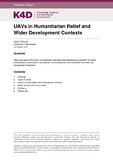| dc.contributor.author | O’Driscoll, Dylan | |
| dc.date.accessioned | 2017-10-03T08:01:18Z | |
| dc.date.available | 2017-10-03T08:01:18Z | |
| dc.date.issued | 2017-08-14 | |
| dc.identifier.citation | O’Driscoll, D. (2017). UAVs in humanitarian relief and wider development contexts. K4D Helpdesk Report. Brighton, UK: Institute of Development Studies. | en |
| dc.identifier.uri | https://opendocs.ids.ac.uk/opendocs/handle/20.500.12413/13245 | |
| dc.description.abstract | The use of Unmanned Aerial Vehicles (UAVs, commonly referred to as drones) is no longer purely the domain of the military and new uses are constantly being developed. In humanitarianism and development the utilisation of UAVs is still a relatively new concept, which initially emerged from the UAV industry’s need for legitimacy. However, in this rapidly developing field their importance and range of purposes is growing daily. Nonetheless, UAV usage is still not widespread as most of the projects are still in the concept and testing phase, with the exception of mapping which been used by NGOs across the globe. Moreover, UAV projects in humanitarianism and development are confined to small, short-range UAVs, as price and lack of access to technologies make larger long-range UAVs difficult to access (Soesilo et al., 2016).
Despite the benefits and capabilities of UAVs, there are a number of criticisms of their use. Many of these criticisms are linked to their origins as tools of war, the perceived technological colonisation of the Global South, and the use of humanitarianism to develop and market technologies for commercial use. These criticisms may die down as the everyday use of UAVs grows and interaction with them becomes normalised. However, issues to do with privacy and data protection are likely to expand with the increased use of UAVs.
This rapid review synthesises the literature on the use of UAVs in humanitarianism and development, whilst highlighting the potential future uses that have been flagged in the literature. It must be noted, however, that due to the rapid development of this technology and the secretiveness that is often paired with commercial developments it is difficult to create a complete and up-to-date list of the uses and developments of UAVs. | en |
| dc.language.iso | en | en |
| dc.publisher | Institute of Development Studies | en |
| dc.relation.ispartofseries | K4D Helpdesk Report; | |
| dc.rights.uri | https://www.nationalarchives.gov.uk/doc/open-government-licence/version/3/ | en |
| dc.subject | Aid | en |
| dc.subject | Humanitarian | en |
| dc.subject | Technology | en |
| dc.title | UAVs in Humanitarian Relief and Wider Development Contexts | en |
| dc.type | Helpdesk | en |
| dc.rights.holder | DFID | en |
| dcterms.dateAccepted | 2017-08-14 | |
| rioxxterms.funder | Default funder | en |
| rioxxterms.identifier.project | K4D | en |
| rioxxterms.version | NA | en |
| rioxxterms.funder.project | 0986883a-6d0f-4bb8-9c46-5e0682934d65 | en |

